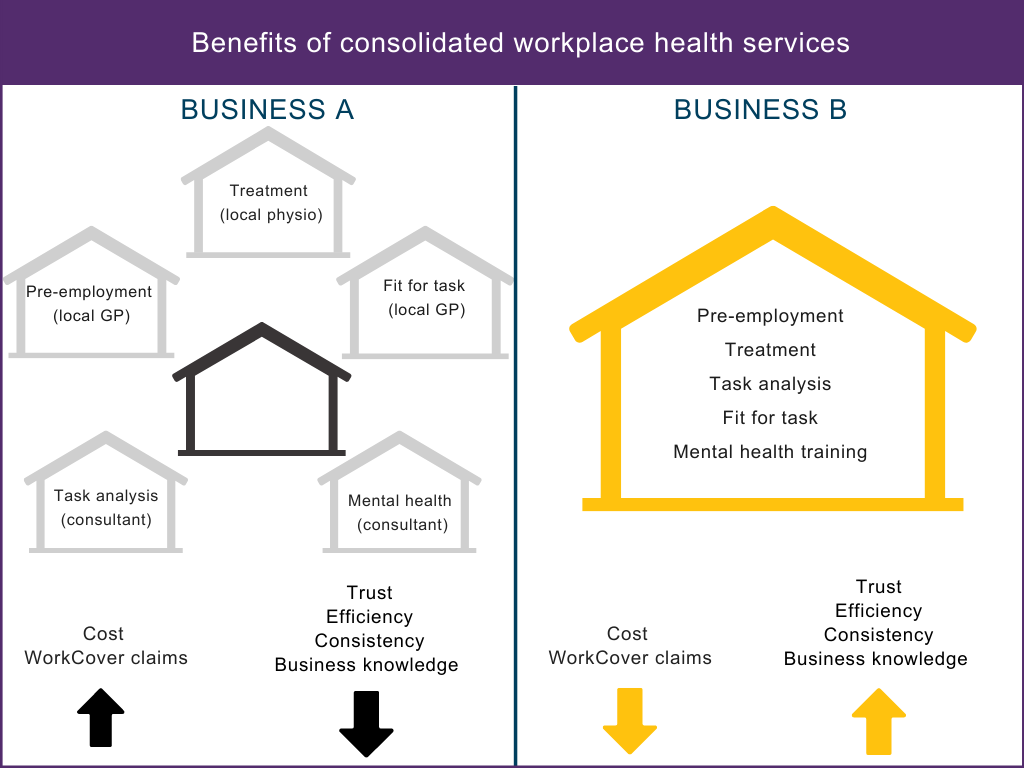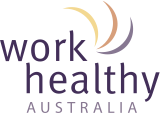
Consolidating your workplace health services and using an on-site model of care has several benefits for your organisation and your employees. The two main compelling reasons are: cost effectiveness and enhanced service provision.
We see many businesses implementing what are often ‘band aid’ solutions for their workplace injury prevention and treatment programs. These are solutions that work in the short-term, but in the end do not achieve the main goals of a workplace health and safety program: reducing lost time injuries (LTIs); keeping employees at work, on full duties; and reducing WorkCover claims.
For example, for pre-employment screens (PES) many businesses use the local GP clinic; for injury treatment and management they send employees to the local physio or GP; and for task analysis and manual handling training they will employ external consultants (or in-house resources that are already stretched and unable to deliver at the standard required).
These businesses have the best intentions – they have spent time preparing their workplace health and safety strategy, they have obtained buy-in from the relevant stakeholders and ultimately they want the best for their employees. However, by using a disjointed selection of healthcare and workplace OH&S providers, they are not getting the most out of their investments.
If your organisation hasn’t implemented an early intervention model of care, you too might be using a piecemeal approach of employing various external agencies to provide the services you require.

Case study: The cost efficiency business case for consolidating your health services
We recently spoke to an organisation who was sending their prospective workers to a GP clinic for PES and who wanted to employ us to run other injury management services. This process was costly and inefficient.
The GP clinic was charging $300 per screen, considerably more than if we performed this on-site for them. Besides the cost per screening, this organisation was also not following an early intervention model of care, which we recommend for best practice injury prevention, treatment and management.
By having the one provider on-site completing the pre-employment screens, as well as injury treatment and management, they would be able to manage this process more efficiently. An on-site provider – having built relationships with employees, completing floor walks, and asking pertinent questions – would be acquainted with the various jobs and tasks the workers had to complete, developing a much better understanding of the work and associated tasks than an external medical clinic, for example.

On-site complete system of care
Besides financial savings, consolidating your occupational health services with an on-site provider means adopting a best practice early intervention model of care.
The most successful workplace injury prevention and treatment programs see health providers truly embedded in the business – operating on-site; treating patients in tandem with the first aid team, completing floor walks, viewing and understanding in detail the tasks that workers undertake on a daily basis. This translates into incredibly more effective pre-employment screens, task analysis, fit for task assessments, more targeted manual handling training, and of course injury treatment and rehabilitation services.
“Workplace health and wellbeing programs improve productivity, creativity and innovation; increase staff morale; improve the management of ageing workers; cut sick-leave rates by an average 25.3 per cent; and slash workers’ compensation costs by more than 40 per cent”. Comcare
On-site providers that understand the physical demands of the work undertaken, build rapport with workers and supervisors on the floor, provide treatment and education help your organisation to proactively retain staff and, over time, see less injuries. The benefits of on-site workplace health services doesn’t stop there. Our work and research shows that onsite workplace health services can:
- Assist with staff retention
- Improve your risk management
- Help your organisation take control of the cost and quality of care
- Improve consistency of reporting
- Improve communication and trust
- Increase your workers knowledge of safe practices
- Improve the recruitment process
To find out more about how consolidation of your occupational health services could benefit your organisation and your employees, speak to us.
Sign up to our monthly enewsletter
"*" indicates required fields
